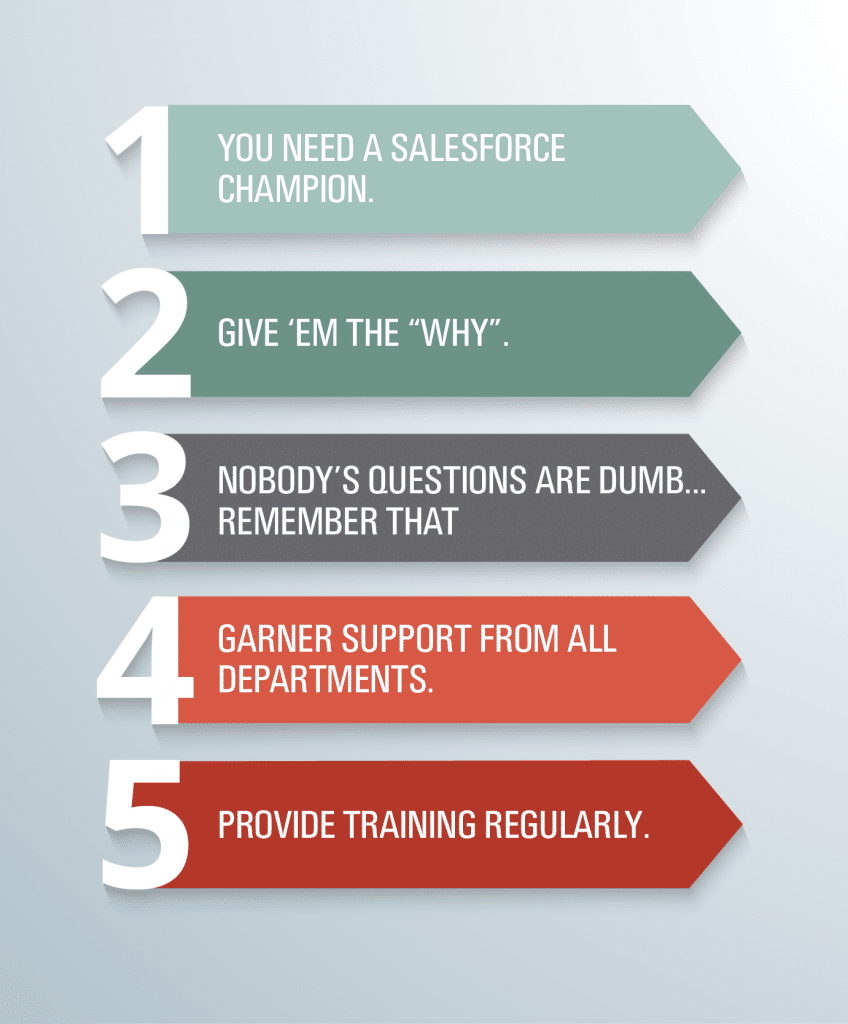Congratulations! Your business has just implemented Salesforce, and you’re now ready to realize some big-time growth. But, wait! Your end users are struggling with logging in for the first time. You want your team to give you a financial forecast of your business, but no one knows how to get to the report. And you want to improve your customer service, but no one understands how to use Service Cloud.
Sound familiar?
 The cadence of confusion that comes with the implementation of new software no longer needs to be part of your business. Here are five game-changing Salesforce training strategies to help maximize adoption.
The cadence of confusion that comes with the implementation of new software no longer needs to be part of your business. Here are five game-changing Salesforce training strategies to help maximize adoption.
1. You need a Salesforce champion.
The first rule for end user training is that you need a go-to guy. For example, if you have multiple people or departments adding or removing fields in Salesforce, then the report will become cluttered and messy. It is better to limit the amount of people who actually have the power to makes changes to maintain a streamlined operation.
Tip: During your Salesforce training sessions, teach your users about the beauty of Salesforce sandboxes. Sandboxes will save you time and energy as you dig around in Salesforce.
2. Give ‘em the “why.”
During the end user training process, many users become overwhelmed with changes, and communication can get diluted as it passes down the chain. When there is a problem in your business that Salesforce can fix, don’t merely identify a way to do something and expect your end users to do it for you. While you are implementing your end user training, it is better that you identify the problem you need fixed, the urgency of the problem from a business perspective, and the impact the change will have on all of your users.This identification process allows your end users to accept for themselves the vision you have for your business and will make it much more desirable for them to help.
Tip: To increase adoption, explain why a change is needed. That will help users become more willing to learn.
3. Nobody’s questions are dumb … remember that.
Be available to provide training, even for the most simple user. With increased knowledge comes increased confidence in using the system. Also, make sure the admins are educated on how best to achieve certain outcomes with Salesforce’s ever-changing platform. This requires continued effort and end user training to stay current with best practices and design solutions. If users don’t know what they are expected to do and why they need to do it, then they are less likely to follow expectations.
Tip: Create very simple Standard Operating Procedures that people can refer to. A one sheet can cut down on the time you spend repeating your training.
4. Garner support from all departments.
As an admin, you need to understand, value, and implement tools from many skill sets. For example, your business analyst can provide end user training from his or her perspective. Your developer creates the best and easiest user experience and understands the software very well. His training could be beneficial to new users. The QA team tests everything in sandbox with both “happy path” and errors and can, once again, provide a completely different point of view in your end user training. The support team understands how it works and what to look for when issues arise. Keep in mind that different departments have a different perspective on how they use SFDC, and the training should be adjusted to make the most impact for the end user.
Tip: Consider a roll-out meeting with department heads spending two minutes each on how the new software will help improve outcomes in their department.
5. Provide training regularly
Organizations change. As SFDC grows and changes, users also need to have sufficient training to follow the dynamics that occur when other departments request modifications. Therefore, all users and their level of end-user training are important. Consensus in the industry dictates that a good training program should account for 10 percent to 13 percent of the total spend. Consider using Powerpoints or simple videos as tools for handling turnover and new employees. Regular training can even come in the form of internal marketing around the office (i.e. posters, reward contests, etc.). The point is that regular, well-organized training equals less Admin support and involvement and will give you more time to focus on running the business.
Tip: Set monthly meetings to go over changes, and reinforce last month’s training while teaching them something new.
End users have different tolerance levels for technology training. So, when you are stewing over how to best train your users on using Salesforce, keep in mind that limiting the amount of people who can make changes, identifying the problem, providing knowledge of the platform, using different skill sets, and providing regular training are all important aspects of end user training that will help you totally nail your Salesforce implementation process.















0 Comments